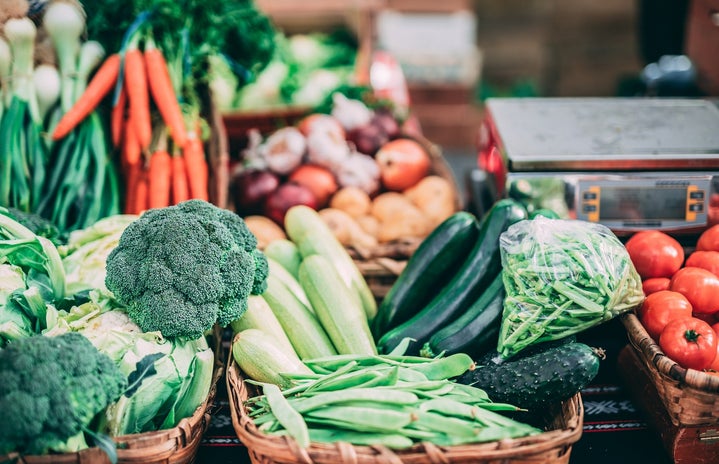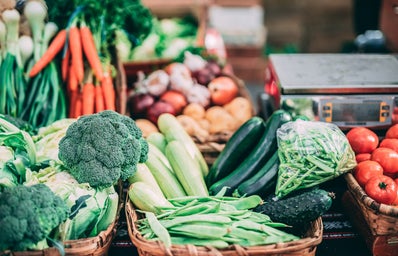Let’s be honest, grocery shopping, meal prep, and healthy, balanced eating usually ranks pretty low on the long list of priorities of a busy college student. Believe me –– as someone who works multiple jobs and participates in several clubs and organizations all while taking 18 or more credits each semester –– I know the feeling. Both time and money are scarce commodities with my current lifestyle
Over the past few months, however, I’ve discovered a newfound appreciation for cooking, and –– for possibly the first time in my life–– I’m nourishing my body properly and sufficiently while educating myself on the importance of nutrition. In all honesty, even just a few months ago I believed that the expectation of “healthy” eating was inherently problematic and classist; and honestly, to an extent, some of those beliefs still ring true. As I share my tips for grocery shopping on a budget with you all, I want to recognize the immense amount of privilege I have as someone who simply has the opportunity to go to different grocery stores with access to items including fresh produce, while nearly 24 million Americans live in food deserts. With that being said, here are my top five tips to reduce your grocery bill while fueling your body with delicious, nutritious meals.
- Buy in bulk.
-
Okay, okay. I know what you’re thinking. This one seems a bit counterintuitive since buying more of something is obviously higher in price than buying a smaller package, right? Wrong… well, kinda. Yes, initially it will be a more expensive grocery trip, but I promise you it’ll be worth it in the long run. Think about some of the bulk food items that are staples in your diet such as grains or legumes. For me, those bulk staples are things like rice, quinoa, oats, and lentils. Now, think about how much you pay for those each time you restock. Let’s take brown rice, for example. For a standard two pound bag of brown rice, the price typically sits at around $2. However, if I were to buy a 10 lb bag of rice, the cost is usually only around $5 or $6. Essentially, you’re getting around four to five pounds of rice for free out of the amount you would have spent had you not bought in bulk. My recommendation is to dedicate a shopping trip to stocking up on bulk foods once you have sufficient funds saved. Depending on how much you buy and how much you eat, these bulk items will likely last you for months.
- Frozen veg is the way to go.
-
In all honesty, purchasing frozen vegetables has been one of my biggest money-saving hacks of all time. Not only can fresh produce be quite expensive, but I also find it often goes bad before I even finish using it all. Some of my go-to frozen vegetables are spinach, broccoli, green beans, cauliflower, peas, and vegetable medleys. Usually a decent sized bag of frozen vegetables ranges in price from less than 80 cents up to around $2, depending on the vegetables. Additionally, frozen vegetables have the same amount of nutrients as their fresh counterparts, so you will still be reaping the health benefits of these produce items even in their frozen form!
- Buy in season.
-
This tip may require you to study up a bit more on fruits and vegetables, but I guarantee this has been one of the most helpful tips I’ve received on grocery shopping, not only for my wallet, but also for getting some of the most delicious and high-quality produce. When you purchase summer fruits, such as watermelon and certain berries in the winter, you may notice that the price is significantly higher than it is in the summer at its peak season. You also may have noticed that despite this higher price, the quality of the fruit is much lower than it would be in season. While I totally understand wanting some of these fruits year round, if you want to get the most bang for your buck, I’d suggest rotating the fruits and veg you buy based on the time of year. Plus, this way you might even get to try some fun, unique produce items!
- Become familiar with the cheapest fruits and vegetables.
-
Similar to the last tip, this one may also require some trial and error based on the items offered at grocery stores near you, however this is something I wish I payed closer attention to sooner. Obviously, there are certain foods that are known for being cheap like potatoes, beans, rice, and oats, so these are always great staples to have in your diet. However, lately I’ve learned that there are some other affordable options available that I previously categorized as expensive. For example, I always associated kale with being an expensive, trendy food like avocado. It wasn’t until I really started observing the prices around me (and comparing prices across various grocery stores) that I learned kale was one of the most affordable and most nutrient-dense vegetables. Now obviously if you were to opt for the organic stuff or go to a place like Whole Foods, you’d be paying significantly more, but usually when I purchase from places like King Soopers or Safeway, I typically spend around 90 cents to a dollar on a pound of kale.
- Track your expenses.
-
Budgeting can be exhausting, but having at least a rough estimate of how much you’ll spend during each grocery trip can help tremendously. If you’re adjusting to a new lifestyle or a new way of eating, be patient with yourself and provide yourself with grace. Keep in mind it’s going to take at least a few grocery trips to learn what works for you and what doesn’t. If you’re still experimenting with different grocery stores in your area or even different brands of foods to find the best prices, I suggest saving your receipts over the course of a month or two and comparing the prices listed in order to find what’s most affordable and/or attainable for you. Remember, this process is all about trial and error, so don’t be too hard on yourself as you’re learning to find balance.
Hopefully these tips will be a helpful starting point next time you find yourself in the grocery store searching for affordable health foods. With this in mind, though, I want to remind everyone that health is subjective. It is completely okay to treat yourself to some Oreos, a pint of ice cream, or a bag of Cheetos once in a while. To me, a healthy lifestyle simply means treating your body in a way that promotes it to function as optimally as it can. Health should never be about punishing your body or feeling guilty about food or denying it the delicious foods its craving. Just some food for thought. Pun intended.



